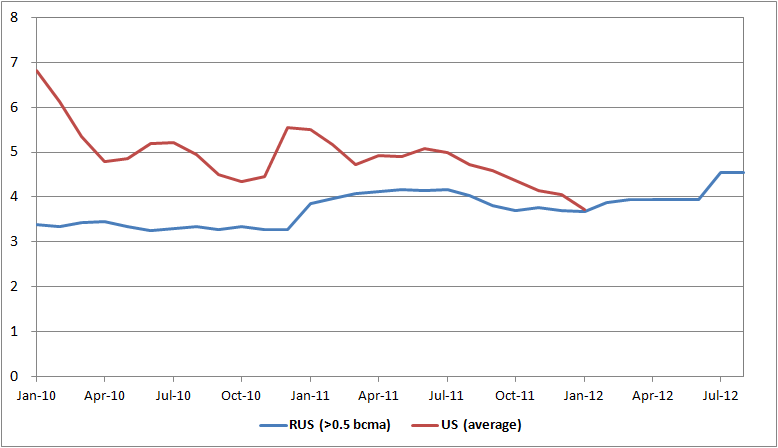|
In a recent analytical paper
Russia's Natural Gas Dilemma (full text with links is
available here), Stratfor claims that Gazprom is losing money on
its domestic sales. This statement is a way outdated. According to
the financial reports of Gazprom, the domestic sales are profitable
from 2004. The important swing from loss to profit was also
mentioned in the company's 2003 annual report (see
page 64).
After two profitable years, Gazprom's
top management has decided that all gas produced at the highest cost
goes to Russian consumers and this simple accounting trick has
created a loss in 2007.
As explained to the shareholders, "stripped gas bought from our
daughter companies is much more expensive than natural gas and the
stripped gas is being delivered exclusively to Russian consumers".
It is worth noting, that in an
arbitration trial in
2002, Gazprom has proved that all stripped gas goes for export
sales (at that time exports of this product were free of customs
duties). In 2008-2011, Gazprom reported profits from the domestic
sales. Gazprom sells gas at the state-regulated wholesale price that
is above the delivery cost in all regions of West Siberia and
European Russia. The article wrongly assumes that Gazprom sells gas
to the end-users. There are no dumping prices of gas in Russia.
As a matter of fact, the low end-use
price of natural gas in Russia is a myth. In January 2012, the
average price of natural gas used by the
US power plants has reached parity with the price paid by major
power plants in Russia that consume over 0.5 bcm/year or over 50
mmcf/day (see the chart below). Moreover, the average price of gas
in Ohio ($3.00/MMBtu) and Pennsylvania ($3.49/MMBtu) is much lower
than the price paid by power plants in Central European Russia. Note
that power
sector represents 30% of the total domestic sales of the Russian
gas giant.
Figure
1. End-use price of natural gas in the power sector of the US and
Russia, USD/MMBtu

Sources: EIA; RF Federal
Tariff Service.
On July 1, 2012, the price for
non-residential consumers will be raised by 15%. The Russian price
for May-August 2012 is our forecast based on the current exchange
rate of the Russian ruble.
It is worth noting that Gazprom is the
least taxed company in the Russian oil-and-gas sector. In 2011,
Russia produced more natural gas than oil in terms of oil
equivalent. However, the total gas production tax collection ($4.6
Bn) was just a fraction of that of oil production tax ($62.9 Bn). In
the period of growing export prices, the Russian government was
steadily reducing the share of
export duties in the export revenue of Gazprom.
According to the Russian government,
the end-use price of gas for non-residential consumers should be at
least twice higher than now. If the price goes that high, Russia is
very likely to start importing fertilizers, cement and other natural
gas-intensive products from the USA. The real dilemma is about that.
Mikhail Korchemkin
East European Gas
Analysis
Malvern, PA, USA
April
23, 2012
P.S. The author has provided
consulting services in anti-dumping cases against Russian companies.
Reproduction or use of
materials is allowed only with reference to East European Gas
Analysis or www.eegas.com
|